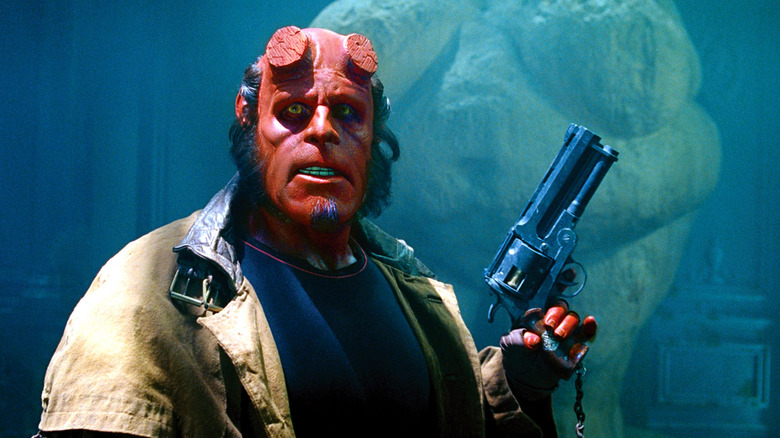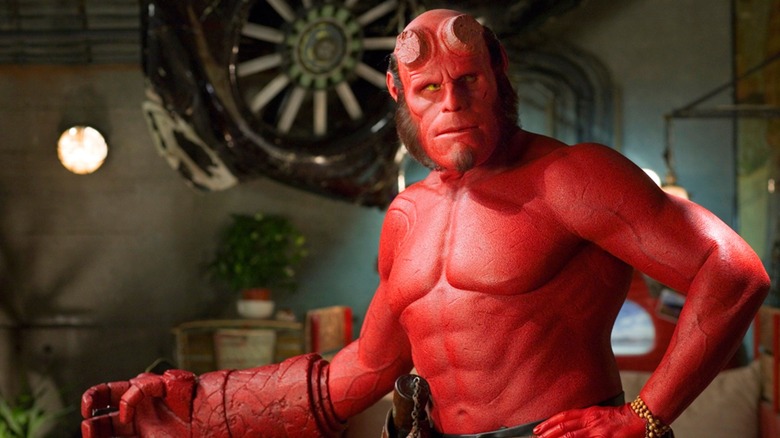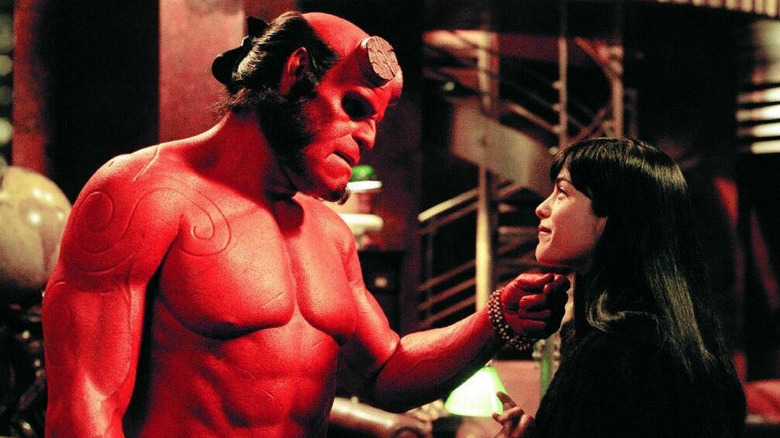The Studio Had Some Strange Ideas For Guillermo Del Toro's Hellboy
Even Best Director winners like Guillermo del Toro must work at the whims of studio executives. In 2004, when del Toro was a much less proven artist on the mainstream stage, his struggle was even greater. Of the four films del Toro had made at the time, only one had been a commercial success: "Blade II." For his next project, del Toro was dead set on adapting Mike Mignola's "Hellboy," another horror-themed comic book superhero. On his journey to get the film made, del Toro received some ... interesting feedback from the studios he courted.
The Studios' not so great ideas
Based on del Toro's recountings, the studios didn't have much faith in "Hellboy." Their fears were likely worsened since Hellboy wasn't a household name with a proven audience like Spider-Man or Batman. In short, the executives were convinced that the premise needed revision, revisions that would've turned the film into a totally different beast from Mignola's comics.
For one, the studios wanted a Hellboy to have a human form and only change into a red-skinned demon when angry, ala the Hulk. The suggestions didn't stop there:
"Then they would suggest things like, 'Can he have a Hellmobile?' 'Can he have a dog? A pet dog that comes from hell and is red?' "It went through every permutation. I had studios where I would start a meeting, and they would say, 'You're not making him red are you?' And I go, 'Yeah, he's red.' 'You're not doing the tail are you?' 'Yes, I'm doing the tail.' 'You're not doing the horns? 'Yes, I'm doing the horns."'
del Toro, however, wanted a "Hellboy" film true to the source material and stayed strong in the face of this pressure to revise. He'd caved to studio demands on a previous film, "Mimic," and his regrets from that experience strengthened his resolve:
"I learned on 'Mimic' that if I make mistakes, I want to do my own. I'd rather make my mistakes than someone else's. With 'Hellboy' it was very much a case of, if I lost that battle then I might as well give up the project."
The director's fortitude paid off; he eventually found a partner in Revolution Studios, who supported his vision for "Hellboy" and financed the $60 million production.
Picking Perlman
An area where del Toro particularly struggled to have his way was with casting the titular hero. Executives wanted a movie star to headline the film; Vin Diesel, fresh off "The Fast and The Furious," was in negotiations for the part. del Toro, on the other hand, wanted Ron Perlman, a character actor he'd worked with on "Cronos" and "Blade II."
"Hellboy is the guy that walks in with his box of tools and says, 'Where's the leak?' He's a working stiff," del Toro explained. "He's a plumber, the guy who says, 'I'm here to fix your monster problem."
Mignola wasn't always a fan of del Toro's creative decisions, but one he wholeheartedly endorsed was casting Perlman: "What Ron brought to it that was so important is that Joe Average, working stiff thing. He already had the attitude of the character, a guy who never really got the red-carpet treatment." Mignola had based Hellboy's "Average Joe" persona on his own father, a Korean war veteran.
Del Toro and Mignola ultimately got the leading man they wanted. To play "Hellboy," Perlman drew on his past role as Vincent in CBS' "Beauty and the Beast," another romantic lead dressed up with inhuman make-up. Diesel's roles as Groot and the Iron Giant show he has a sensitive side, but it's still hard to imagine him playing Hellboy with as much personality as Perlman brought to the part, or nailing the romance with Liz Sherman (Selma Blair).
Del Toro's "Hellboy" saga is missing a concluding chapter, for the third film never escaped development hell. The two films he did get to make couldn't have been made by anyone except him. It speaks ill of Hollywood that he had to fight so hard to make them the way they are.


